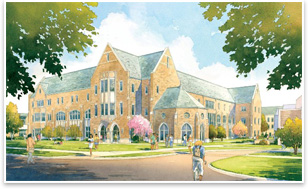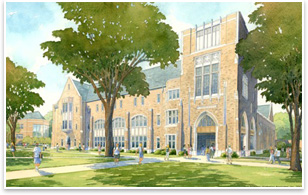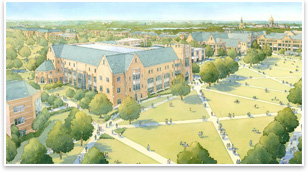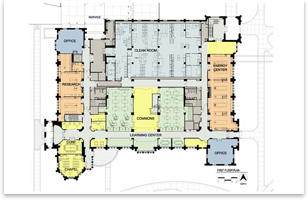Fighting Irish Tackle Climate Change Through Design
Notre Dame embraces LEED on campus
by Heather Livingston
Contributing Editor
 Summary: The University of Notre Dame is taking steps to address climate change. They have created a Web site devoted to sustainability issues that states: “As a Catholic academic community of higher learning, the University of Notre Dame and its faculty, staff, and students believe we have a responsibility to advocate the principles and live out the practices of energy and environmental stewardship.” As testament to their commitment, Notre Dame recently retained BSA LifeStructures to design its first LEED® certified building for its College of Engineering. With a price tag of $69.4 million, the new 161,000-square-foot Stinson-Remick Hall will be the flagship of the engineering department and provide modern facilities for undergraduate and graduate students, including a clean room and nanotechnology lab. Designed in collaboration with RFD and Maregatti Interiors, the building was designed to create spaces that foster collaboration and experiential learning and discovery. Summary: The University of Notre Dame is taking steps to address climate change. They have created a Web site devoted to sustainability issues that states: “As a Catholic academic community of higher learning, the University of Notre Dame and its faculty, staff, and students believe we have a responsibility to advocate the principles and live out the practices of energy and environmental stewardship.” As testament to their commitment, Notre Dame recently retained BSA LifeStructures to design its first LEED® certified building for its College of Engineering. With a price tag of $69.4 million, the new 161,000-square-foot Stinson-Remick Hall will be the flagship of the engineering department and provide modern facilities for undergraduate and graduate students, including a clean room and nanotechnology lab. Designed in collaboration with RFD and Maregatti Interiors, the building was designed to create spaces that foster collaboration and experiential learning and discovery.
 Stinson-Remick Hall, designed in the university’s Collegiate Gothic style, will replace the two-building Cushing/Fitzpatrick Hall of Engineering complex as the primary engineering facility. The Neo-Gothic Cushing was built in 1932, with Fitzpatrick constructed in 1979 to be completely continuous with Cushing Hall. Geoff Lisle, AIA, BSA LifeStructures principle-in-charge, reports that although Cushing/Fitzpatrick will continue to serve the engineering department, it was no longer fulfilling the technological needs of the department. “Technology has changed,” he says. “Methods of research and instruction have changed, and the original capacities and design issues were causing them some limitations.” Notre Dame broke ground on Stinson-Remick in November, with an anticipated completion in fall 2009. Stinson-Remick Hall, designed in the university’s Collegiate Gothic style, will replace the two-building Cushing/Fitzpatrick Hall of Engineering complex as the primary engineering facility. The Neo-Gothic Cushing was built in 1932, with Fitzpatrick constructed in 1979 to be completely continuous with Cushing Hall. Geoff Lisle, AIA, BSA LifeStructures principle-in-charge, reports that although Cushing/Fitzpatrick will continue to serve the engineering department, it was no longer fulfilling the technological needs of the department. “Technology has changed,” he says. “Methods of research and instruction have changed, and the original capacities and design issues were causing them some limitations.” Notre Dame broke ground on Stinson-Remick in November, with an anticipated completion in fall 2009.
One building, many spaces
Stinson-Remick will house an interdisciplinary learning center for undergraduate students, the new Notre Dame Energy Center, and a nanotechnology center. The interdisciplinary learning center is the physical and metaphorical heart of the building, explains Lisle, providing undergraduate students with a blend of computer work stations, library resources, and laboratory space. “Its design creates a dynamic, team-based undergraduate academic space to serve the evolving curriculum. By creating a connection between the learning center and research areas, the environment will provide students with a more complete learning experience,” explains Lisle.
 The Notre Dame Energy Center will focus on developing new energy technology to meet national and international needs. As part of its research, the university is installing a micro-turbine in the basement and PV panels on the roof. In addition, all utility usage will be monitored by the students so they can see the effects of different energy strategies. Lisle says that it made sense from both a research and educational standpoint for the university to position the energy center in the new facility. “They wanted it to be more visible, where people could see it and get curious about it,” he says. “They wanted the undergraduates to have exposure to that program and they wanted to have the opportunity to interact with other research that’s going on in the building.” The Notre Dame Energy Center will focus on developing new energy technology to meet national and international needs. As part of its research, the university is installing a micro-turbine in the basement and PV panels on the roof. In addition, all utility usage will be monitored by the students so they can see the effects of different energy strategies. Lisle says that it made sense from both a research and educational standpoint for the university to position the energy center in the new facility. “They wanted it to be more visible, where people could see it and get curious about it,” he says. “They wanted the undergraduates to have exposure to that program and they wanted to have the opportunity to interact with other research that’s going on in the building.”
The nanotechnology center includes a 9,000-square-foot semiconductor processing and device fabrication clean room. Rather than separating and hiding activities that take place within labs and the nanotechnology center behind opaque walls, parts of the new building will be wrapped in glass “envelopes,” allowing people to see what’s going on through double glass walls, including many of the building’s technical functions that might normally be hidden.
 Testing the waters Testing the waters
“This was the first project that Notre Dame had looked at from a LEED standpoint, so their approach was a little bit more conservative,” says Lisle. “But we have evaluated and continue to evaluate the LEED approach and when it’s all said and done, we may achieve something more than the initial base goal of LEED certification.”
Lisle says that because it was the first foray into LEED for Notre Dame, there were a number of evaluations that had to be made, including the campus infrastructure and central plant and client education on sustainability and the LEED process. In addition, the extreme conditions necessary for lab facilities can make it difficult to achieve LEED points. Although this is the first project on the Notre Dame campus to seek LEED certification, the university has clearly found the process worthwhile. Three other new university buildings are now in the process of becoming certified, Lisle says
| 




